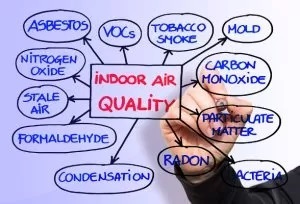
Maintaining good air quality in your home is essential for the health and well-being of you and your family. Poor air quality can lead to respiratory problems, allergies, and other health issues. Therefore, it’s crucial to regularly test the air quality in your home to ensure a clean and healthy living environment. In this article, we will explore some methods and techniques you can use to test the air quality in your home.
Identify Potential Pollutants: Before you begin testing the air quality, it’s important to identify the potential pollutants that may be present in your home. Common indoor air pollutants include volatile organic compounds (VOCs), mold, dust mites, pet dander, pollen, and tobacco smoke. Knowing what to look for will help you choose the right testing methods.
Visual Inspection: Start by conducting a visual inspection of your home. Look for signs of mold or mildew, water damage, or excessive dust accumulation. Check for any visible signs of leaks, condensation, or dampness, as these can contribute to poor air quality.
Test for Allergens: Allergens like dust mites, pollen, and pet dander can significantly affect indoor air quality. You can use allergen test kits available in the market to check for the presence of these allergens. These kits often involve collecting a sample using swabs or strips and sending them to a laboratory for analysis.
Carbon Monoxide (CO) Testing: Carbon monoxide is a colorless, odorless gas that can be emitted by faulty gas appliances, fireplaces, or generators. High levels of CO can be extremely dangerous. To test for carbon monoxide, you can use a carbon monoxide detector or an indoor air quality monitor that includes CO monitoring capabilities.
Radon Testing: Radon is a radioactive gas that can seep into homes through cracks in the foundation or basement. Long-term exposure to high levels of radon can increase the risk of lung cancer. Radon test kits are available to measure the levels of radon in your home. These kits typically involve placing a small device in the lowest livable area of your home for a specified period.
Formaldehyde and VOC Testing: Formaldehyde and volatile organic compounds (VOCs) are often found in household products like paints, adhesives, cleaning agents, and furniture. High levels of these chemicals can cause respiratory problems and other health issues. You can use formaldehyde and VOC test kits to measure the levels of these compounds in your home.
Air Quality Monitors: Air quality monitors are devices designed to measure and monitor various aspects of indoor air quality. They can detect and measure pollutants such as particulate matter, temperature, humidity, carbon dioxide (CO2), and volatile organic compounds. Air quality monitors provide real-time data and can help you identify problem areas in your home.
Professional Testing: If you’re unable to pinpoint the source of poor air quality or if you want a comprehensive assessment, it may be beneficial to hire a professional indoor air quality testing company. They have specialized equipment and expertise to conduct thorough testing and provide detailed reports on the air quality in your home.
In conclusion, testing the air quality in your home is an essential step in ensuring a healthy living environment. By identifying potential pollutants, conducting visual inspections, and utilizing various testing methods such as allergen testing, carbon monoxide testing, radon testing, and formaldehyde/VOC testing, you can gain a better understanding of the air quality in your home. Regular testing and monitoring, along with appropriate measures to mitigate any issues identified, will contribute to maintaining clean and healthy indoor air for you and your loved ones.
Call Florence HVAC Pros today if you need the air quality in your home tested!
Like our Facebook page for more great info about heating and cooling.
Florence HVAC Experts
Florence, SC 29501
843-636-3260
http://florencehvacexperts.com/

No comments:
Post a Comment